radiator cap PONTIAC BONNEVILLE 1995 Owners Manual
[x] Cancel search | Manufacturer: PONTIAC, Model Year: 1995, Model line: BONNEVILLE, Model: PONTIAC BONNEVILLE 1995Pages: 338, PDF Size: 16.19 MB
Page 192 of 338
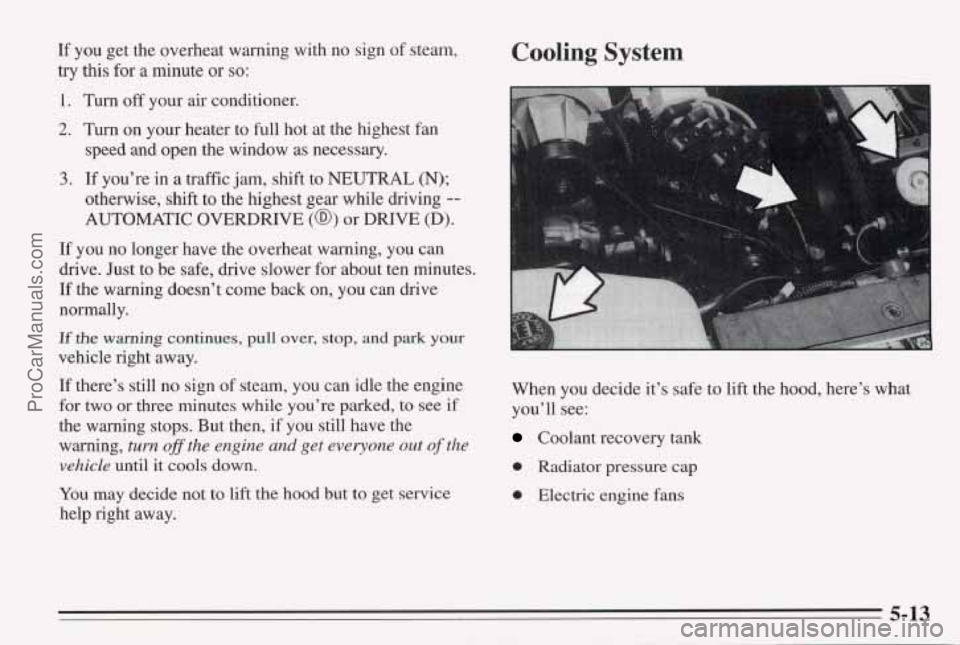
If you get the overheat warning with no sign of steam,
try
this for a minute or so:
1. Turn off your air conditioner.
2. Turn on your heater to full hot at the highest fan
speed and open the window as necessary.
3. If you’re in a traffic jam, shift to NEUTRAL (N);
otherwise, shift to the highest gear while driving --
AUTOMATIC OVERDRIVE (@) or DRIVE (D).
If y’ou no longer have the overheat warning, you can
drive. Just to be safe, drive slower for about ten minutes.
If the warning doesn’t come back
on, you can drive
normally.
If the warning continues, pull over, stop, and park your
vehicle right away.
If there’s still
no sign of steam, you can idle the engine
for two or three minutes while you’re parked, to see if
the warning stops. But then, if you still have the
warning,
turn off the engine and get everyone out of the
vehicle until it cools down.
You may decide not to lift the hood but to get service
help right away.
Cooling System
When you decide it’s safe to lift the hood, here’s what
you’ll see:
Coolant recovery tank
0 Radiator pressure cap
0 Electric engine fans
5-13
ProCarManuals.com
Page 196 of 338
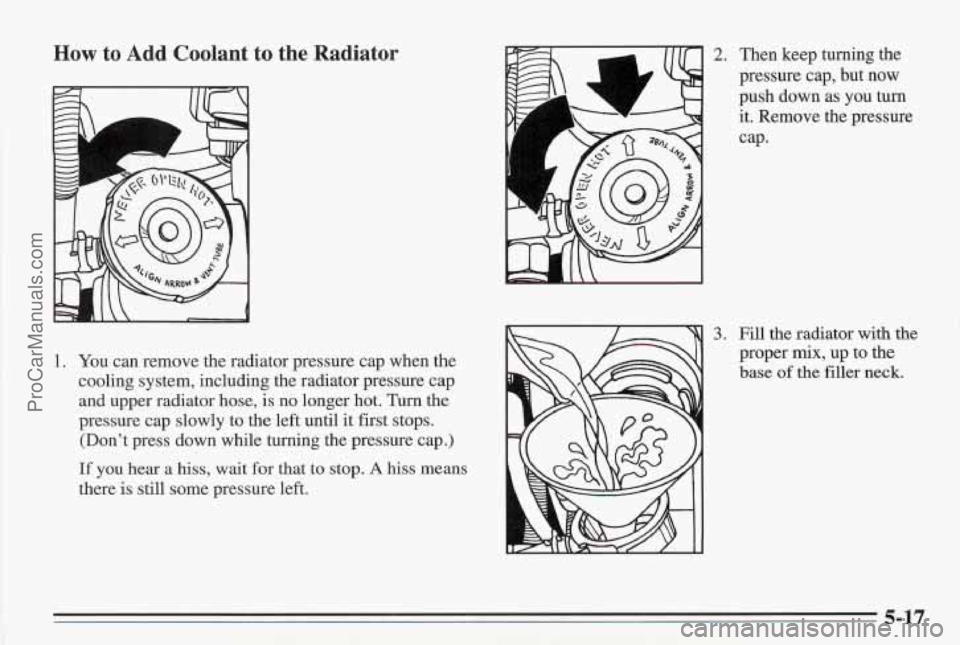
How to Add Coolant to the Radiator
7'
1. You can remove the radiator pressure cap when the
cooling system, including the radiator pressure cap
and upper radiator hose,
is no longer hot. Turn the
pressure cap slowly to the left until it first stops.
(Don't press down while turning the pressure cap.)
If you hear a hiss, wait for that to stop. A hiss means
there is still some pressure left.
rr' 1
2. Then keep turning the
pressure cap, but now
push down
as you turn
it. Remove the pressure
cap.
3. Fill the radiator with the proper
mix, up to the
base
of the filler neck.
5-17
ProCarManuals.com
Page 197 of 338
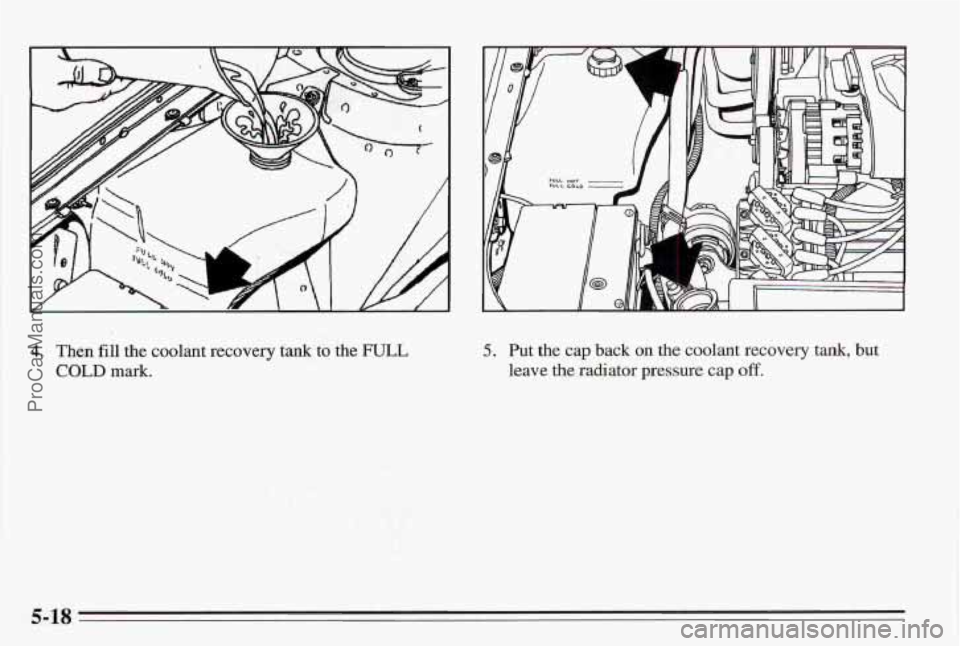
I'
4. Then fill the coolant recovery tank to the FULL
COLD mark.
5. Put the cap back on the coolant recovery tank, but
leave the radiator pressure cap off.
5-18
ProCarManuals.com
Page 198 of 338
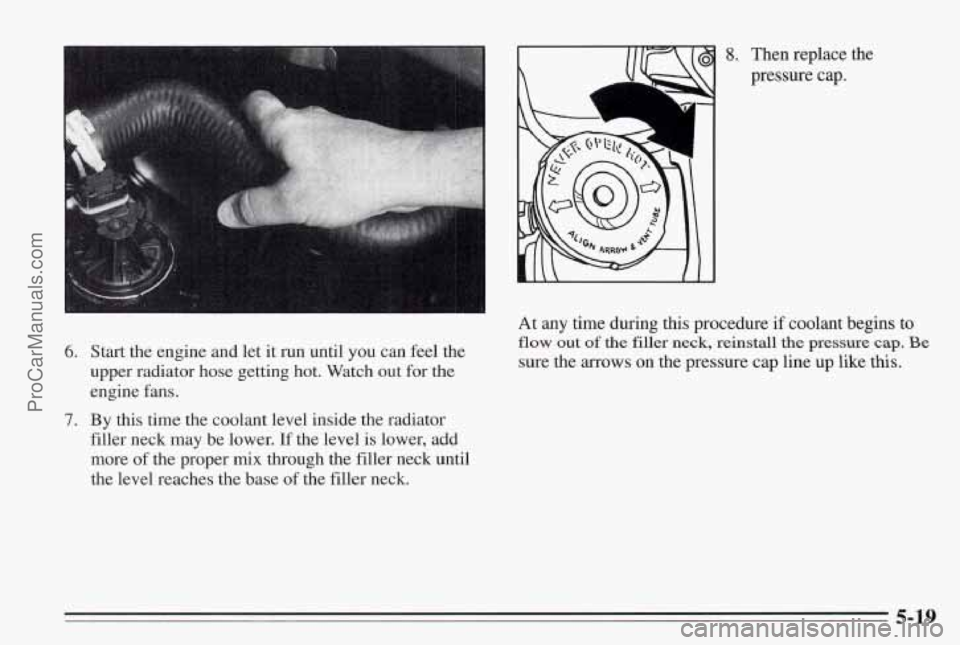
6. Start the engine and let it run until you can feel the
upper radiator hose getting hot. Watch out for the
engine fans.
7. By this time the coolant level inside the radiator
filler neck may
be lower. If the level is lower, add
more
of the proper mix through the filler neck until
the level reaches the base
of the filler neck.
8. Then replace the
pressure cap.
At any time during this procedure
if coolant begins to
flow out of the filler neck, reinstall the pressure cap. Be
sure the arrows on the pressure cap line up like this.
5-19
ProCarManuals.com
Page 237 of 338
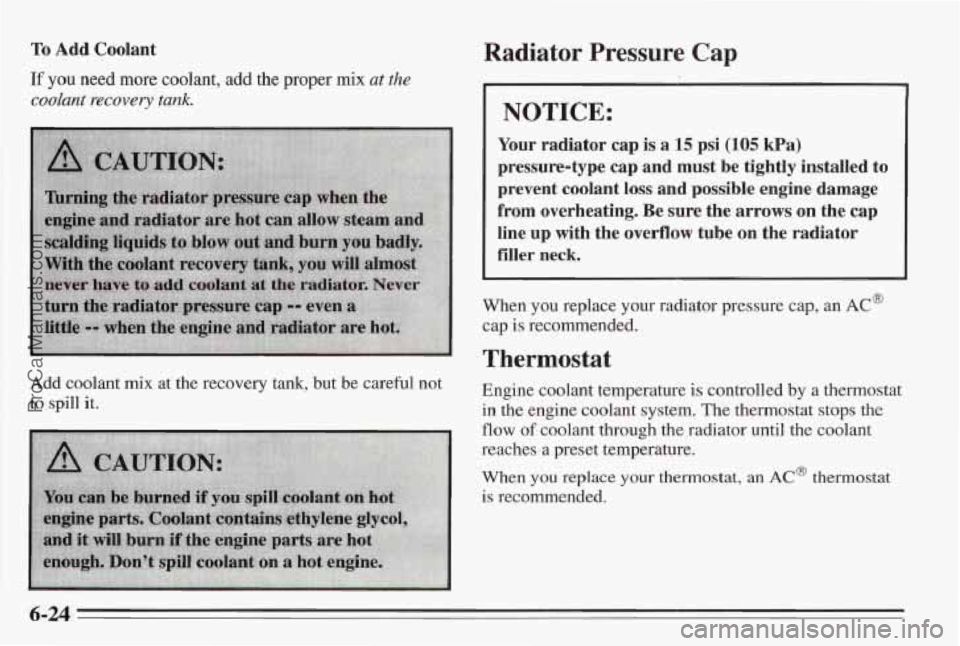
To Add Coolant
If you need more coolant, add the proper mix at the
coolant recovery tank.
Add coolant mix at the recovery tank, but be careful not
to spill it.
Radiator Pressure Cap
NOTICE:
Your radiator cap is a 15 psi (105 kPa)
pressure-type cap and must be tightly installed to
prevent coolant
loss and possible engine damage
from overheating. Be sure the arrows on the cap
line up with the overflow tube on the radiator
filler neck.
When you replace your radiator pressure cap, an AC@
cap is recommended.
Thermostat
Engine coolant temperature is controlled by a thermostat
in the engine coolant system. The thermostat stops
the
flow of coolant through the radiator until the coolant
reaches a preset temperature.
When you replace your thermostat, an AC@ thermostat
is recommended.
6-24
ProCarManuals.com
Page 239 of 338
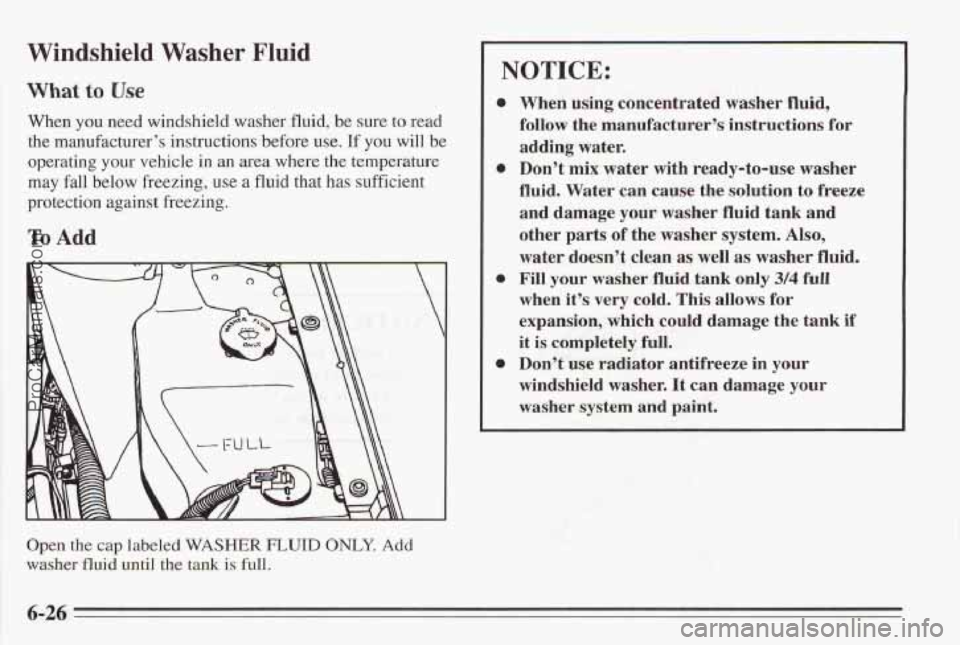
Windshield Washer Fluid
What to Use
When you need windshield washer fluid, be sure to read
the manufacturer’s instructions before
use. If you will be
operating your vehicle in an area where the temperature
may fall below freezing, use a fluid that has sufficient
protection against freezing.
To Add
Open the cap labeled WASHER FLUID ONLY. Ad’d
washer
fluid until the tank is full.
NOTICE:
0
When using concentrated washer fluid,
follow the manufacturer’s instructions for
adding water.
Don’t
mix water with ready-to-use washer
fluid. Water can cause the solution to freeze
and damage your washer fluid tank and
other parts
of the washer system. Also,
water doesn’t ‘clean as well as washer fluid.
Fill your washer fluid tank only 3/4 full
when it’s very cold. This allows for
expansion, which could damage the tank
if
it is completely full.
Don’t us’e radiator antifreeze in your
windshield washer. It can damage
your
washer system and paint.
L
6-26
ProCarManuals.com
Page 280 of 338
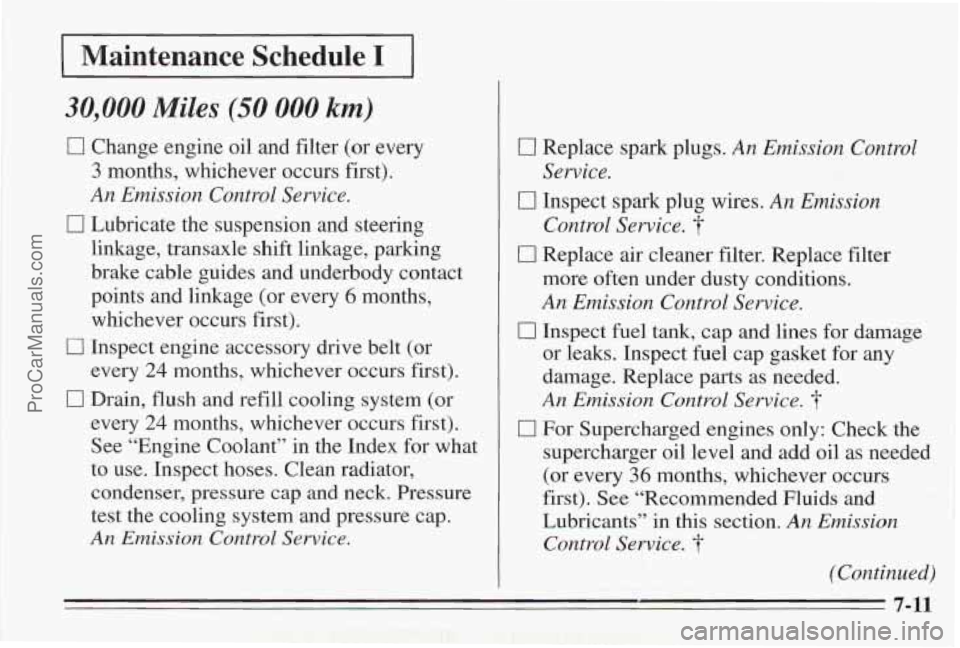
Maintenance Schedule I
30,000 Miles (50 000 km)
0 Change engine oil and filter (or every
3 months, whichever occurs first).
An Emission Control Service.
0 Lubricate the suspension and steering
linkage, transaxle shift linkage, parking
brake cable guides and underbody contact
points and linkage (or every
6 months.
whichever occurs first).
0 Inspect engine accessory drive belt (or
every 24 months, whichever occurs first).
0 Drain, flush and refill cooling system (or
every
24 months, whichever occurs first).
See “Engine Coolant’’ in the Index for what
to use. Inspect hoses. Clean radiator,
condenser, pressure cap and neck. Pressure
test the cooling system and pressure cap.
An Emission Control Service.
0 Replace spark plugs. An Emission Control
0 Inspect spark plug wires. An Emission
0 Replace air cleaner filter. Replace filter
Service.
Control Service.
-f
more often under dusty conditions.
An Emission Control Service.
0 Inspect fuel tank, cap and lines for damage
or leaks. Inspect fuel cap gasket for any
damage. Replace parts as needed.
An Emission Control Service. 4
[7 For Supercharged engines only: Check the
supercharger oil level and add oil as needed
(or every
36 months, whichever occurs
first). See “Recommended Fluids and
Lubricants” in this section.
An Emission
Control Service.
(Continued)
7-11
ProCarManuals.com
Page 286 of 338
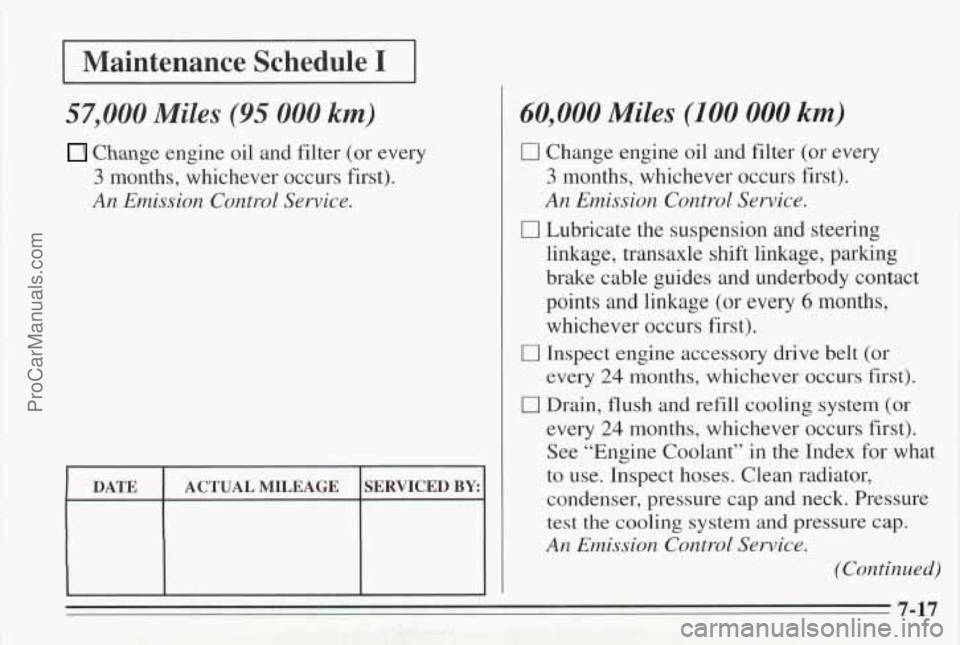
.. .. I
, .’
I Maintenance Schedule I I
57,000 Miles (95 000 km)
Change engine oil and filter (or every
3 months, whichever occurs first).
An Emission Control Service.
DATE SERVICED BY ACTUAL MILEAGE
60,000 Miles (100 000 km)
I7 Change
engine oil and filter (or every
3 months, whichever occurs first).
An Emission Control Service.
0 Lubricate the suspension and steering
linkage, transaxle shift linkage, parkmg
brake cable guides and underbody contact
points and linkage (or every
6 months,
whichever occurs first).
17 Inspect engine accessory drive belt (or
every
24 months, whichever occurs first).
0 Drain, flush and refill cooling system (or
every
24 months, whichever occurs first).
See “Engine Coolant’’ in the Index for what
to use. Inspect hoses. Clean radiator,
condenser, pressure cap and neck. Pressure
test the cooling system and pressure cap.
An Emission Control Service.
(Continued)
7-17
ProCarManuals.com
Page 292 of 338
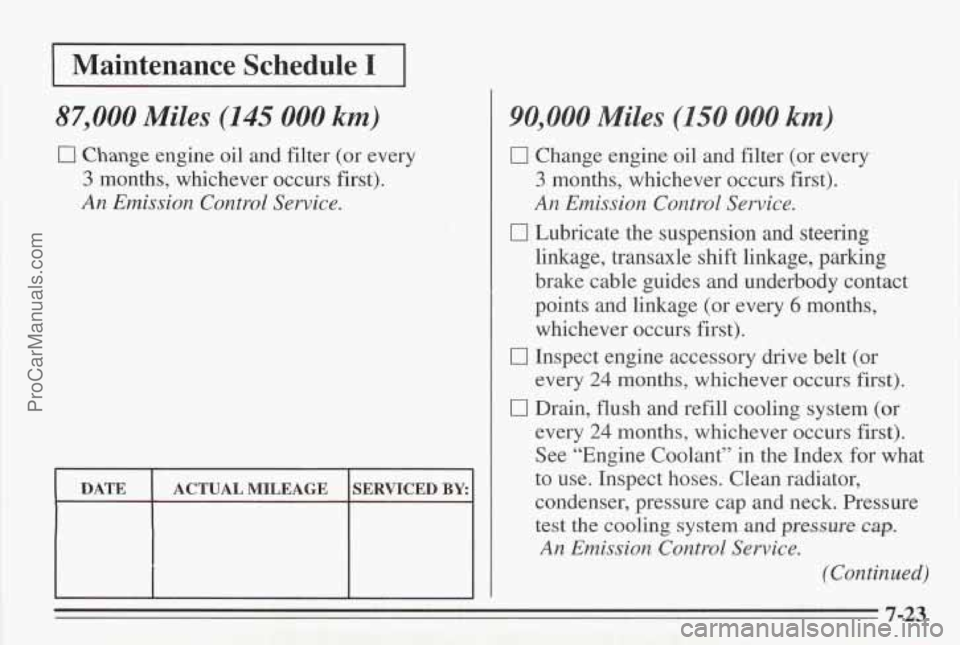
1 Maintenance Schedule I I
87,000 Miles (145 000 km)
0 Change engine oil and filter (or every
3 months, whichever occurs first).
An Emission Control Service.
DATE
SERVICED BY: ACTUAL MILEAGE
90,000 Miles (150 000 km)
0 Change engine oil and filter (or el
Jery
3 months, whichever occurs first).
An Emission Control Service.
0 Lubricate the suspension and steering
linkage, transaxle
shift linkage, parking
brake cable guides and underbody contact
points and linkage (or every
6 months,
whichever occurs first).
0 Inspect engine accessory drive belt (or
every
24 months, whichever occurs first).
0 Drain, flush and refill cooling system (or
every 24 months, whichever occurs first).
See “Engine Coolant’’ in the Index for what
to use. Inspect hoses. Clean radiator,
condenser, pressure cap and neck. Pressure
test the
cooling system and pressure cap.
An Emission Control Service.
(Continued)
7-23
ProCarManuals.com
Page 298 of 338
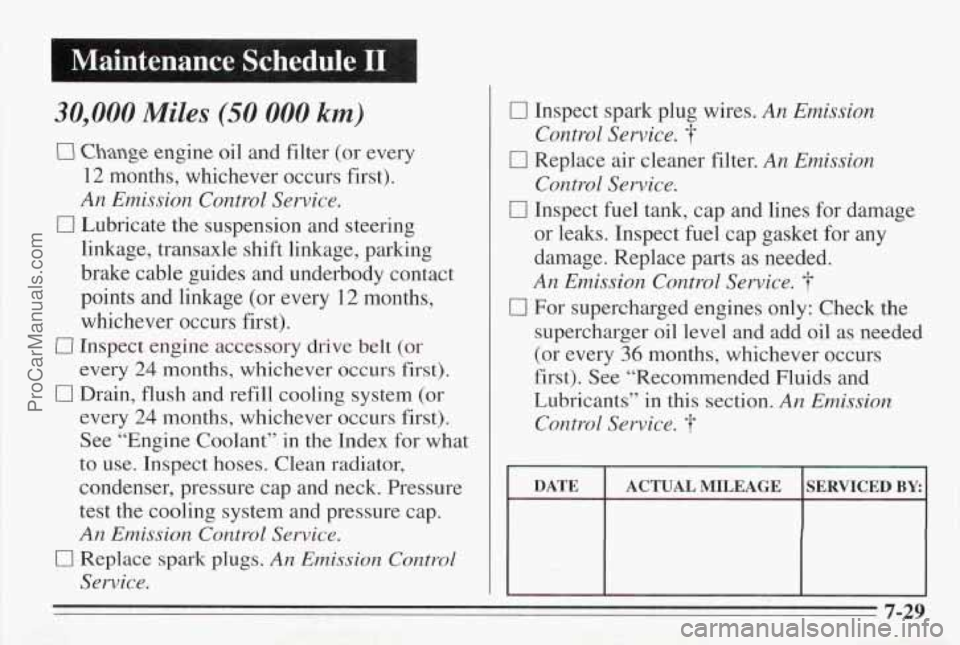
flaintenance Schedule I1 I
30,000 Miles (50 000 km)
El Change engine oil and filter (or every
12 months, whichever occurs first).
An Emission Control Service.
0 Lubricate the suspension and steering
linkage, transaxle shift linkage, parking
brake cable guides and underbody contact
points and linkage (or every
12 months,
whichever occurs first).
CI Inspect engine accessory drive belt (or
every 24 months, whichever occurs first).
0 Drain, flush and refill cooling system (or
every
24 months, whichever occurs first).
See “Engine Coolant” in the Index for what
to use. Inspect hoses. Clean radiator,
condenser, pressure cap and neck. Pressure
test the cooling system and pressure cap.
An Emission Control Service.
0 Replace spark plugs. An Emission Control
Service.
0 Inspect spark plug wires. An Emission
Control Service.
0 Replace air cleaner filter. An Emission
Control Service.
0 Inspect fuel tank, cap and lines for damage
or leaks. Inspect fuel cap gasket for any
damage. Replace
parts as needed.
An Emission Control Service. 3-
0 For supercharged engines only: Check the
supercharger oil level and add oil as needed
(or every
36 months, whichever occurs
first). See “Recommended Fluids and
Lubricants” in this section.
An Emission
Control Service.
7-29
ProCarManuals.com